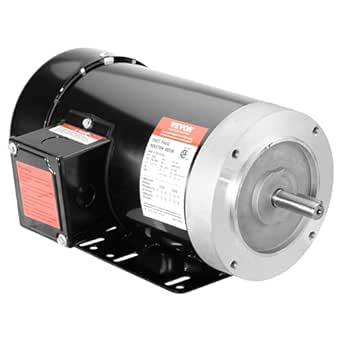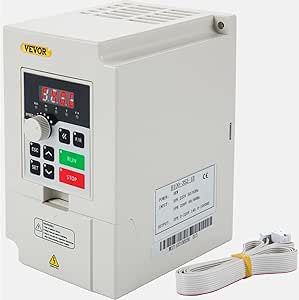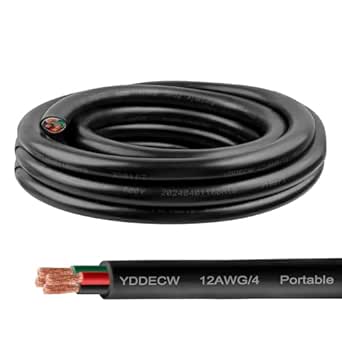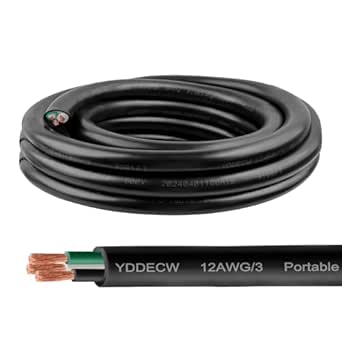VFD / Motor Setups
Wiring a Variable‑Speed 2 × 72 Grinder or 6‑inch Disc Sander
(Power options: 240 V single‑phase in → 240 V three‑phase out or 240 V three‑phase in → 240 V three‑phase out)
Why I still swear by a 6‑inch disc
- Consumables everywhere – hook‑and‑loop, PSA, and Roloc discs are dirt‑cheap and stocked in every hardware aisle.
- Lightning‑fast grit changes – velcro discs pop off in seconds, so you stay in the grinding zone.
- Low inertia – the smaller plate spins up quicker and keeps inrush current gentle on the VFD.
Shopping list
| Qty | Component | Notes |
|---|---|---|
| 1 | 2 HP three‑phase TEFC motor, 56C face (e.g., VEVOR 230/460 V, 3450 RPM) | Move the internal jumpers to 230 V. |
| 1 | 3 kW VFD (single‑phase or three‑phase input → three‑phase output) | Choose at least 150 % of motor FLA. |
| 1 | Harbor Freight “Apache” Pelican‑style case (~ $20 on sale) | Dust‑ and splash‑proof enclosure for the VFD. |
| 10 ft | 12 AWG SOOW | 3‑conductor for single‑phase feed, 4‑conductor for three‑phase feed. |
| 10 ft | 12 AWG 4‑conductor SOOW | VFD → motor (U/V/W + ground). |
| 1 | Plug that matches your receptacle | L6‑20P/L6‑30P for single‑phase, L15‑20P/L15‑30P for three‑phase. |
| — | Liquid‑tight glands, strain‑reliefs, conduit | Preserve the case seal. |
| — | Ring terminals sized to your VFD studs | Import drives often use skinny M4 screws—grind tongues to fit. |
| — | Basic electrical toolkit | Strippers, crimper, multimeter, screwdrivers, zip‑ties, wire nuts. |
Protecting the real weak link — the VFD
The drive’s PCB hates steel dust and stray coolant. Hiding it in a $20 Apache Pelican‑clone keeps it alive:
- Penetrations only where needed * Gland #1 – line cord. * Gland #2 – motor whip. * Grommet #3 – low‑voltage cable for the Vevor remote pendant (already IP‑65).
- Mount on nylon standoffs – ½‑inch clearance keeps heat off the plastic.
- Active ventilation, filtered – 40 mm fan + replaceable MERV‑13 pad on a side wall; air exits through a louver opposite.
- Install the case above the grinder’s spark plume – wall bracket or mast arm; gravity is your friend.
- Remote pendant out in the open – It’s rugged, sealed, and happy to live in the grit.
Input wiring options
| Shop power | Cord & plug | VFD line terminals |
|---|---|---|
| 240 V single‑phase | 3‑cond. 12 AWG + L6‑20P/L6‑30P | Hots → R/L1, S/L2 (or P/N); ground to chassis. |
| 208‑240 V three‑phase | 4‑cond. 12 AWG + L15‑20P/L15‑30P | Hots → R/L1, S/L2, T/L3; ground to chassis. |
Output is always three‑phase: U, V, W ➜ T1, T2, T3 on the motor + ground.
Step‑by‑step hookup (right out of the box)
Safety first: keep the cord unplugged while building the harness. The VFD is powerless until you intentionally connect it to mains.
- Prep the line cord – strip jacket, crimp lugs, feed through gland, land on the VFD line terminals.
- Prep the motor whip – strip jacket, crimp U/V/W/GND lugs, feed through second gland, land on the VFD output terminals.
- Seat the VFD in the case, route the pendant ribbon through its grommet, latch the box shut.
- Wire the plug to match your shop receptacle/breaker.
- Now de‑energize the circuit at the panel, plug the cord in, and close the breaker.
- Program baseline parameters (tweak later):
| Setting | Typical value | Why |
|---|---|---|
| Rated voltage | 230 V | Matches motor nameplate |
| Rated current | ~6.5 A | Electronic overload |
| Base freq. | 60 Hz | North‑American standard |
| Max freq. | 120 Hz | Double‑speed for light finishing |
| Accel/Decel | 3–5 s | Prevents belt whip & current spikes |
| Control mode | 3‑wire | Remote pendant handles start/stop & speed |
Shop‑tested tips
- Check rotation at 10 Hz – swap any two output leads if it runs backward.
- Ferrite choke on motor leads tames RF hash in shop radios/LEDs.
- Change the filter pad every few months—cheap insurance.
- Wire a mushroom E‑stop (NC) in the low‑voltage control circuit and test before every session.
- Trim ring lugs on an 80‑grit belt if they’re too wide for the VFD terminals.
Bottom line
Seal the VFD inside the $20 Pelican‑clone, let the rugged pendant face the grit, and you’ll enjoy rock‑solid variable speed—from a 5 Hz crawl to 120 Hz warp—powered by the same bargain 6‑inch discs you already keep in stock, whether your shop feed is single‑phase or true three‑phase.






